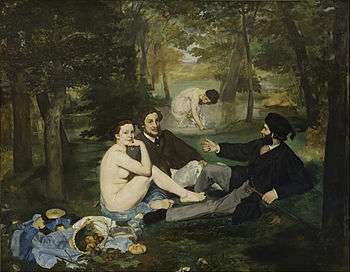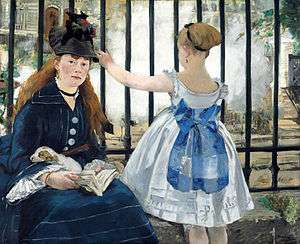Victorine Meurent
| Victorine-Louise Meurent | |
|---|---|
.jpg) Victorine Meurent, c. 1865, album of portraits belonging to Édouard Manet | |
| Born |
February 16, 1844 Paris |
| Died |
March 17, 1927 Colombes |
| Nationality | French |
| Education | Étienne Leroy (1828-1876) |
| Known for | Painter |
Victorine-Louise Meurent (also Meurant) (February 18, 1844[1] – March 17, 1927) was a French painter and a famous model for painters. Although she is best known as the favourite model of Édouard Manet, she was also an artist in her own right who regularly exhibited at the prestigious Paris Salon. In 1876 her paintings were selected for inclusion at the Salon's juried exhibition, when Manet's work was not.
Biography
Born in Paris to a family of artisans (her father was a patinator of bronzes, while her mother was a milliner), Meurent started modeling at the age of sixteen in the studio of Thomas Couture and may also have studied art at his women's atelier.[2] Meurent first modeled for Manet in 1862, for his painting The Street Singer.[3] Manet was first drawn to Meurent when he saw her in the street, carrying her guitar. She was particularly noticeable for her petite stature, which earned her the nickname La Crevette (The Shrimp),[4] and for her red hair, which is depicted as very bright in Manet's watercolor copy of Olympia. As well as playing the guitar, Meurent also played the violin, gave lessons in the two instruments, and sang in café-concerts.
Meurent's name remains forever associated with Manet's masterpieces of 1863, The Luncheon on the Grass and Olympia, which include nude portrayals of her. At that time she also modeled for Edgar Degas and the Belgian painter Alfred Stevens, both close friends of Manet. Her relationship with Stevens is said to have been particularly close.
Manet continued to use Meurent as a model until the early 1870s, when she began taking art classes and they became estranged, as she was drawn to the more academic style of painting that Manet opposed. The last Manet painting in which Meurent appears is Gare Saint-Lazare (Not to be confused with Monet's painting of the same name), painted in 1873, which is often referred to as The Railway. The painting is considered the best example of Manet's use of contemporary subject matter.
In 1875, Meurent began studying with the portraitist fr:Étienne Leroy.[3] The following year, Meurent first submitted work of her own at the Salon and was accepted.[5] Ironically, Manet's own submissions were rejected by the jury that year. Bourgeoise de Nuremberg au XVIe siècle,[6] Meurent's entry at the Académie des Beaux-Arts in 1879, was hung in the same room as the entry by Manet. Work by Meurent also was included in the 1885 and 1904 exhibitions.[3] In all, Meurent exhibited in the Salon six times. She also continued to support herself by modelling through the 1880s for Norbert Goeneutte, an artist best known for his etchings, and for Toulouse-Lautrec, who took to introducing her as Olympia.
Meurent was inducted into the Société des Artistes Français in 1903, with the support of Charles Hermann-Leon and Tony Robert-Fleury, the Société's founder. By 1906 Meurent had left Paris for the suburb of Colombes, where she lived with a woman named Marie Dufour for the remainder of her life.[3] The two appear to have shared ownership of their house. In her eighties she continued to refer to herself as an artist, as recorded in a census from that time. Meurent died on March 17, 1927. After the death of Dufour in 1930, the contents of the house were liquidated; in the late twentieth century, elderly neighbours recalled the last contents of the house, including a violin and its case, being burnt on a bonfire.
A painting by Meurent, Le Jour des Rameaux or Palm Sunday was recovered in 2004 and now hangs in the Colombes History Museum.
Paintings
 Palm Sunday, c. 1880s, Musée Municipal d'Art et d'Histoire de Colombes
Palm Sunday, c. 1880s, Musée Municipal d'Art et d'Histoire de Colombes
Meurent in fiction
Victorine Meurent's life has inspired two historical novels, and she appears as a character in several others.
The Irish writer George Moore included Meurent as a character in his semi-fictional autobiography, Memoirs of My Dead Life (1906). She appears as a middle-aged woman past her prime, living in a lesbian relationship with a famous courtesan.
Meurent is the protagonist of both Mademoiselle Victorine: a Novel (2007) by Debra Finerman and A Woman With No Clothes On (2008) by V R Main and is a character in Christopher Moore's novel Sacré Bleu (2012).
She is also a character in the film Intimate Lives: The Women of Manet, aka Manet in Love (1998) and is played by Shelley Phillips.
Meurent in Manet's works
Meurent in Alfred Stevens's works
Further reading
- Friedrich, Otto. Olympia: Paris in the Age of Manet New York: Touchstone, 1993.
- Lipton, Eunice. Alias Olympia. ISBN 0-8014-8609-2. 1992.
- Main, V R. A Woman With No Clothes On. London: Delancey Press, 2008. ISBN 978-0-9539119-7-4. 2008.
- Seibert, Margaret Mary Armbrust. 1986. A Biography of Victorine-Louise Meurent and Her Role in the Art of Édouard Manet. Diss. The Ohio State U., 1986.
References
- ↑ Archives de Paris; canadp-archivesenligne.paris.fr
- ↑ Jimenez, Jill Berk (2001). Dictionary of Artist's Models. London: Routledge. p. 372.
- 1 2 3 4 Summers, Claude J (2004). The Queer Encyclopedia of the Visual Arts. Cleis Press.
- ↑ Ross King, The Judgement of Paris, p.37
- ↑ Dictionnaire général des artistes de l'École française depuis l'origine des arts du dessin jusqu'à nos jours : architectes, peintres, sculpteurs, graveurs et lithographes. p.80 Gallica BnF
- ↑ Salon des artistes français 1879, no.2128; Gallica BnF
External links
| Wikimedia Commons has media related to Victorine Meurent. |
- The Naked Truth, by V R Main
- Salon 1885, № 1755
- Société des artistes français Salon 1904, № 1264
- Le Bulletin de la vie artistique, 1921/05/15 (A2,N10), p.297; Gallica BnF
- La Vie parisienne : la ville et le théâtre : 1884 (à 1889) / par Parisis (Emile Blavet), p.122; Gallica BnF Le Figaro (Paris. 1854), 1884/03/02 (Numéro 62), p.1; Gallica BnF
- L'Hôtel Drouot et la curiosité en 1883-1884, p.173; Gallica BnF







